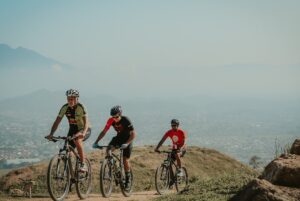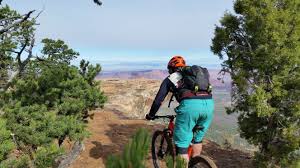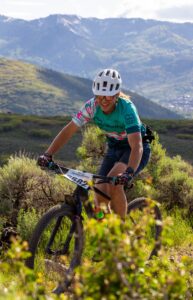Key Takeaways
-
Understanding tread patterns, puncture resistance, and tire size is crucial for selecting the best all-terrain MTB tires.
-
Maxxis, Specialized, and WTB are among the top brands offering reliable all-terrain tires suitable for senior riders.
-
Tubeless tires offer benefits like reduced punctures and a smoother ride, especially on challenging trails.
-
Proper tire pressure is key to performance and comfort; it varies based on rider weight and trail conditions.
-
Regular maintenance and knowing how to troubleshoot common tire issues can extend the life of your MTB tires.
Best all-terrain MTB tires
It’s crucial to consider factors like terrain, riding style, and conditions. The choice of tires significantly impacts your bike’s performance and handling. Here are some top picks for mountain bike tires in 2024:
Schwalbe Racing Ray Addix Speed:
-
Price: £51.99 / $65 / €58.99
-
Weight: 692g claimed weight
-
Size: 29×2.25in
-
Features: Fast-rolling tread pattern, front-specific tread design, Addix Speed Rubber compound for grip, speed, and durability12
-
WTB Verdict 2.5 TCS Tough High Grip:
-
Price: £58 / $79.95 / €63.50
-
Weight: 1,345g claimed weight
-
Size: 29×2.5in
-
Features: Excellent wet-weather grip, ideal for sloppy and soft trails, best used as a front tire12
-
Specialized Butcher T9 Grid Trail:
-
Features: Utilizes a slow rebound damping compound for predictable grip and handling in various conditions, offers excellent damping through rocky or rooty sections, not overly heavy with good climbing performance4
-
Maxxis Dissector:
-
Features: Known for high performance in aggressive and trail riding, offers excellent grip and control on various terrains4
-
When selecting mountain bike tires, factors like rubber compound, tread pattern, durability, puncture protection, tire width, and tubeless compatibility are essential considerations. Cross-country tires prioritize less rolling resistance, while trail and enduro tires have larger knobs for better grip in challenging terrains4
Remember that wider tires may not always offer more grip; the tread pattern plays a significant role in a tire’s performance4
Gearing Up for Adventure: Senior’s Guide to All-Terrain MTB Tires
There’s a certain kind of freedom in mountain biking that’s ageless. Whether you’re 25 or 65, the call of the trails is just as strong. But as we age, our choice in gear, especially tires, plays a pivotal role in how we enjoy the ride. All-terrain MTB tires are the unsung heroes that can make or break an outing. They’re your first line of defense against the unpredictable off-road world. Let’s dive into what makes a tire capable of handling anything the trail throws at it.

Factors that Define the Best All-Terrain Tires
When we talk about all-terrain, we mean tires that excel on a variety of surfaces. These tires have to balance grip, durability, and comfort. The tread must be aggressive enough for traction in mud and loose dirt, yet roll smoothly on hardpack. They should resist punctures from thorns and sharp rocks while cushioning the ride over roots and ruts. And for us seniors, we need tires that help us maintain control without requiring Olympian strength.
Embracing the Trail at Every Age
Mountain biking isn’t just for the young guns. It’s a lifelong sport, and as we grow older, we appreciate the nuances even more. The right tire can mean more confident cornering, less fatigue, and more fun. That’s why choosing the best all-terrain MTB tire isn’t just about the bike; it’s about embracing the trail at every age.

Differences Between XC, Trail, and Enduro MTB Tires
When comparing XC, trail, and enduro mountain bike tires, several key differences emerge based on the specific terrain and riding styles they are designed for:
XC Tires:
-
Tread Design: Optimized for speed and climbing traction.
-
Rubber Layers: Typically lighter with less rubber for reduced rolling resistance.
-
Puncture Protection: Focus on lightweight construction rather than heavy-duty puncture protection.
-
Brakes: Equipped with lightweight two-piston brakes for adequate stopping power.
-
Wheel Size: Commonly feature 29-inch wheels for efficiency and momentum over obstacles.
-
Cockpit Setup: Forward weight bias position for efficient climbing.
-
Trail Tires:
-
Tread Design: Additional layers of rubber for better puncture protection and a more aggressive tread pattern.
-
Rubber Layers: Thicker rubber layers to enhance durability and puncture resistance.
-
Suspension: Can have a minimum of 120mm of suspension travel for better handling on varied terrain.
-
Brakes: Equipped with bigger four-piston calipers and larger rotors for enhanced stopping power.
-
Wheel Size: Offer a mix of 29-inch, 27.5-inch, or even “mullet” bikes with different wheel sizes.
-
Enduro Tires:
-
Tread Design: Designed for aggressive downhill riding with a focus on traction and control.
-
Rubber Layers: Durable construction with robust rubber layers to withstand rough terrain.
-
Suspension: Longer travel suspension systems ranging from 140mm to 170mm for improved handling on technical descents.
-
Brakes: Feature powerful braking systems with larger rotors and finned brake pads for better thermal management.
-
Wheel Size: Typically equipped with larger wheels for stability and control during descents.
-
In summary, XC tires prioritize speed and climbing traction, trail tires offer a balance between puncture protection and grip, while enduro tires focus on durability and control in aggressive downhill riding scenarios. The choice of tire depends on the rider’s preferences, terrain, and riding style to ensure optimal performance on the trails24

Trailblazing Tire Traits: What to Look For
When selecting tires, focus on tread pattern, puncture resistance, and size. These factors will help you find the perfect tire for your riding style and the trails you love. Most importantly, remember that the best tire for someone else might not be the best for you. Personal preference and local trail conditions play a huge role in your choice.
Tread with Intent: The Patterns That Conquer All Trails
The tread of a tire is like the sole of a hiking boot—it determines the grip. Look for tires with a versatile tread pattern that offers stability on various terrains. A good all-terrain tire will have:
-
Nobly treads for loose surfaces
-
Spaced-out patterns to shed mud
-
Smaller knobs in the center for less rolling resistance on hard surfaces
It’s a balancing act, but the right tread will keep you upright and moving forward, no matter what’s under your wheels.
Rugged as They Come: Puncture Resistance and Durability
There’s nothing worse than a flat tire on the trail. For those of us who want to spend more time riding and less time fixing, puncture resistance is key. Look for tires with a robust casing and extra layers of material that protect against sharp objects. Besides that, a durable tire will withstand the wear and tear of rocky trails, meaning fewer replacements and more riding.

Size Matters: Finding the Perfect Fit for Stability and Comfort
Choosing the right size tire is about stability and comfort. A wider tire can offer more grip and a smoother ride, while a narrower tire might be faster and lighter. Consider your bike’s clearance and the kind of trails you’ll be riding. If you’re cruising through forest paths with lots of roots, a wider tire could be your best friend. On the other hand, for well-maintained trails, you might prefer the nimbleness of a narrower option.
1. Max Priority – Grip and Control on Uncertain Grounds
For seniors hitting the trails, control is paramount. You want tires that cling to the earth like roots to soil. That’s where the Maxxis Minion series comes into play. The Minion DHF, for instance, offers an aggressive tread pattern designed for maximum traction. The side knobs grip at various angles, which is crucial when you’re navigating through a mix of dry and wet conditions.
But grip isn’t just about the tread; it’s also about the rubber compound. Maxxis uses its 3C MaxxTerra compound, which is engineered to balance grip, durability, and rolling resistance. This means you’ll have tires that not only hold the ground firmly but also last longer and keep you rolling smoothly on those long descents and climbs.
2. The Durability Champion – Longevity Meets the Trail
When you’re out on the trail, the last thing you want to worry about is your tires giving out. Durability is where brands like Specialized step in with their Grid casing technology. The Specialized Butcher, for example, is built to endure. Its casing is reinforced to protect against punctures and cuts, giving you the peace of mind to ride over sharp rocks and through thorny underbrush without a second thought.
What’s more, Specialized’s Gripton compound is a testament to the tire’s longevity. It’s designed to maintain its performance characteristics over a wide range of temperatures, so whether you’re riding in the heat of summer or the cool of autumn, your tires will perform consistently.
And remember, a durable tire doesn’t just save you from flats. It also means fewer tire changes and, therefore, less strain on your wallet and the environment.

3. Comfort Crusader – Smooth Rides for the Long Haul
Comfort on the trail isn’t a luxury; it’s a necessity, especially for senior riders. WTB’s range of tires, with their ample volume and supportive casing, provide a plush ride that can absorb the jolts and jars of uneven terrain. The WTB Ranger, in particular, with its high-volume design, allows for lower tire pressures, which translates to a more forgiving ride on the roots and rocks.
Moreover, the Ranger’s tread is designed to roll efficiently on hardpack while still offering enough bite for loose over hard conditions. It’s the kind of tire that encourages you to take the long way home, knowing you’ll be comfortable every pedal stroke of the journey.
4. The Lightweight Performer – Easy on the Bike and Legs
As we focus on enjoying the trails, we shouldn’t have to battle with heavy tires that sap our strength. That’s where the Vittoria Mezcal comes into the picture. It’s a tire that’s as light as it is effective, with a fast-rolling tread pattern that won’t weigh you down. The Mezcal’s low-profile knobs reduce drag, making it easier to keep the momentum going, which is particularly beneficial when you’re looking to conserve energy on longer rides.
The tire’s lightweight nature also means it’s easier to handle when it comes to installation or carrying a spare. It’s about making the ride as enjoyable as possible, and a lighter tire plays a big role in that equation.

5. All-Weather Warrior – Best for Rain or Shine Adventures
No matter what the forecast says, you’re ready to ride. But is your tire? Michelin’s Wild AM2 is designed to tackle a variety of weather conditions, making it a true all-weather warrior. Its tread pattern features aggressive shoulder knobs for cornering in loose conditions and a more densely packed center for fast rolling on wet or dry surfaces.
What’s more, Michelin’s Gum-X3D technology combines three different rubber compounds for the perfect balance of grip, traction, and durability, regardless of the weather. This means you can hit the trails with confidence, knowing your tires are up for the challenge, come rain or shine.
Optimizing Your Ride: Setting Up Your MTB Tires
Now that we’ve covered some of the best tires out there, let’s talk about setting them up for optimal performance. A great tire that’s poorly installed won’t do you any favors. It’s about getting the details right, from bead to bead.
From Bead to Bead: A Step-by-Step on Mountain Bike Tire Installation
Installing your MTB tires can seem daunting, but it’s a skill that will serve you well. First, ensure your rim is clean and free from debris. Next, slightly inflate your new tire to give it shape, and then place one bead onto the rim. Work the tire onto the rim by hand, and then do the same with the other bead. Be careful not to pinch the tube (if you’re using one). Once both beads are on, inflate the tire to the recommended pressure, and you’re set to go!
To Tube or Not to Tube: Tubeless Tires Decoded
Tubeless tires are increasingly popular, and for good reason. They offer a reduction in flats, a smoother ride, and the ability to run lower pressures for better traction. If you’re considering going tubeless, you’ll need tubeless-ready rims and tires, a tubeless valve, and sealant. The setup process involves adding sealant to the tire, seating the tire onto the rim, and inflating it until you hear the satisfying ‘pop’ of the bead setting into place.
Pressure Points: Perfect PSI for Your All-Terrain Rides
Finding the right tire pressure is a game of balance. Too high, and you’ll bounce off every rock and root; too low, and you risk pinch flats and rim damage. Start with the manufacturer’s recommended pressure and adjust based on your weight and the trail conditions. A general rule is to run lower pressures for more grip and comfort on rough trails, and higher pressures for efficiency on smoother paths.
Ride with Confidence: Tire Maintenance Tips
Maintaining your tires is just as important as choosing the right ones. Regular checks can help you spot potential problems before they spoil your ride. Look for cuts, bulges, or excessive wear. If you spot anything that looks unusual, it’s better to deal with it at home than on the trail. Besides that, clean your tires after muddy rides to prevent debris from damaging the rubber and compromising the grip.
Regular Checks – The Key to Prolonging Tire Life
Make it a habit to inspect your tires before and after rides. Check for any sharp objects that may be lodged in the tread and remove them. Look for signs of sidewall damage or wear on the tread that could indicate it’s time for a replacement. By keeping an eye on your tire’s health, you can ensure they last as long as possible, saving you time and money in the long run.
Trailhead Troubleshooting – Fast Fixes for Common Tire Issues
Even with the best preparation, issues can arise. It’s wise to carry a repair kit that includes a spare tube, a patch kit, tire levers, and a pump or CO2 inflator. If you get a flat, replace or patch the tube and check the tire for whatever caused the puncture. A quick fix on the trail can be the difference between a great day and a long walk back to the car.

Frequently Asked Questions (FAQ)
As a senior mountain biker, you might have some questions about all-terrain MTB tires. Here are answers to some of the most common queries, so you can hit the trails with confidence. For more detailed insights, check out our health benefits of mountain biking for seniors.
How often should I replace my MTB tires?
Typically, mountain bike tires need replacing after 1,500 to 2,500 miles, but this varies based on riding style, terrain, and the tire’s build quality. Inspect your tires regularly for signs of wear, such as worn down treads or sidewall cracks. If you ride in particularly rough terrain, you may need to replace them more frequently.
Can I mix and match different tire brands on my MTB?
Yes, you can mix and match different tire brands on your mountain bike. Some riders prefer a more aggressive tread on the front tire for better control and a faster-rolling tread on the rear for improved speed. Just make sure both tires are compatible with your bike’s rims and suitable for the terrain you’ll be riding.
What pressure should I run my all-terrain tires at for rockier trails?
For rockier trails, you’ll want to run a lower tire pressure to increase grip and absorb shocks. Start with the manufacturer’s recommended pressure and adjust downwards as needed. A pressure of 25-30 PSI could be a good starting point, but always consider your weight and the tire’s volume. It’s about finding that sweet spot where comfort and control meet.
Are wider tires better for seniors?
Wider tires can offer more stability and comfort, which can be beneficial for seniors. They distribute weight better and provide a larger contact patch with the ground, which translates to improved traction. However, they are also heavier and can require more effort to pedal. Balance your need for comfort with the type of riding you do most often.
Do the best all-terrain tires come in foldable options?
Many high-quality all-terrain tires come in foldable options. Foldable tires are easier to transport and install, and they often use a higher-quality, lighter-weight casing material, which can improve ride quality. However, they might be more expensive than non-foldable tires, so consider your budget and priorities when choosing.


